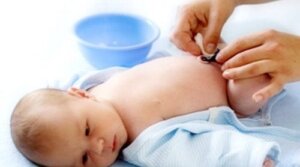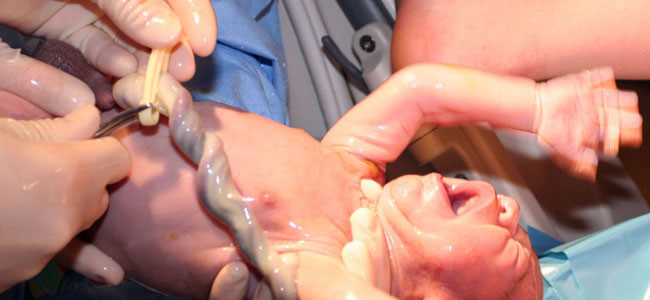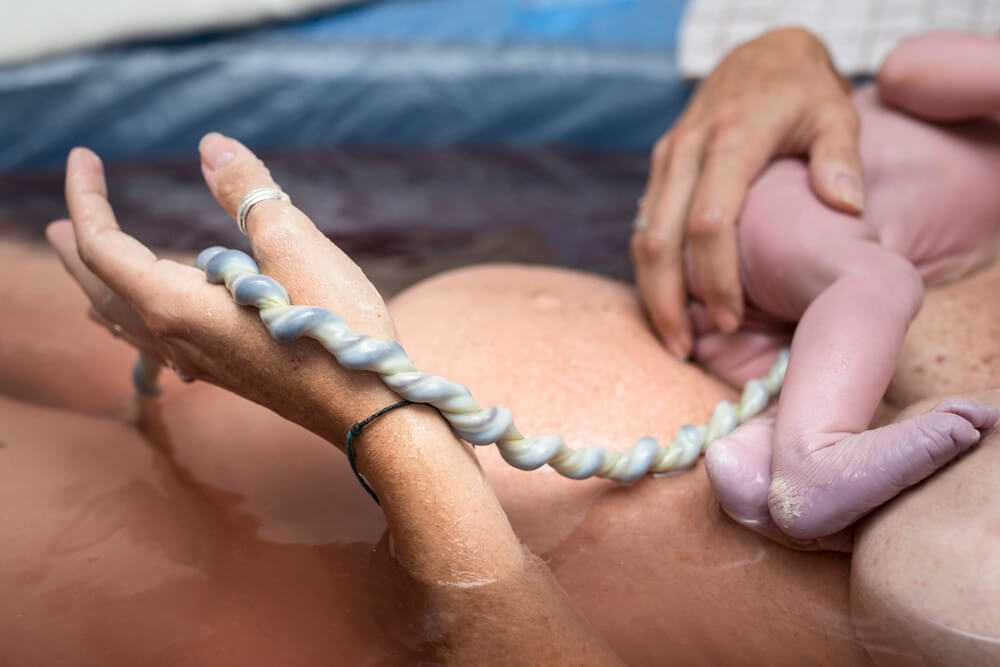Keys for Cleaning the Umbilical Cord

Caring for the newborn’s umbilical cord during and after birth can reduce infections and infant deaths. Cleaning the umbilical cord is a simple and fast task, but also delicate and very important. You must do it confidently and calmly because there are no nerve endings in the umbilical cord. So, unless it becomes infected, the baby won’t feel pain.
When your baby’s umbilical cord–which held you together for nine months–is cut, a stump remains in their body that must dry, heal, and fall off on its own. During this healing process, the cord should be kept as clean and dry as possible. It’s important to be careful during this period, which can last for about 15 days.
Specialists especially recommend that the parents of newborn babies keep the cord very clean. While it’s drying, there’s a high risk of infection because the exposed vessels facilitate the entry of germs into the body. This can quickly lead to a serious infection that can be life-threatening to your baby. This caveat shouldn’t unnerve you because this process is quick and simple.

What you should know about your baby’s umbilical cord
- The umbilical cord should dry out and fall off when the baby is approximately 5 to 15 days old.
- There are specialists in the health area who recommend cleaning it only with gauze and water. However, there are those who do it with a disinfectant such as alcohol, physiological solution, or another antiseptic product. You can ask your pediatrician what their recommendation is.
- Some pediatricians recommend that you give your baby a sponge bath during this time and that you don’t submerge them in a bathtub with water until the cord has fallen off. But this is also a tip that you can consult with your child’s doctor.
- Clean and dry the umbilical cord every time you change the baby’s diaper and try to keep the area ventilated. For this purpose, you can use special diapers for newborns.
- Let the cord fall naturally. Never try to pull it, even if it’s just hanging by a thread.

What should cleaning the umbilical cord look like?
- First of all, it’s always good to have everything you use to clean the cord within reach. This way, the task will be faster and easier. Once this is done, wash your hands with water and disinfectant soap so you’ll maintain the asepsis of the area.
- The best position to clean your baby’s cord is when they’re lying down. When you have them in this position, apply water or a medical disinfectant to the cord and its surroundings to prevent the area from becoming infected. Then clean the area with gauze or cotton swabs.
- Your baby may cry, and that usually happens because the disinfectant or alcohol that you’re putting on them is cold, not because their navel hurts or because you’re doing things wrong.
- Always make sure that the diaper exposes the area of the cord, as this will help it dry faster.
It’s also very important that during this daily task, you’re very attentive to the signs of local infection in the cord:
- Yellowish, foul-smelling discharge from the cord
- Redness, swelling, or tenderness of the skin around the umbilical cord
It’s also good to know the signs of a more serious infection. If you detect them, you should contact the baby’s pediatrician as quickly as possible. These signs are:
- Poor feeding
- Fever of 100.4° F or higher
- Lethargy
- Poor and flaccid muscle tone
Aspects to consider in the care of the umbilical cord
If the cord is pulled or hit, it can start active bleeding, which means that every time one drop of blood is wiped away, another appears. If this happens, call your doctor immediately.
You also need to know that sometimes, instead of drying out completely, the cord will form pinkish scar tissue, called a granuloma.
This granuloma drains a clear, yellowish fluid. This often goes away in about a week. If it doesn’t, you also need to call your baby’s pediatrician. You should do the same if the cord hasn’t fallen off in four weeks or a month, as this could indicate a problem with the baby’s anatomy or immune system.
Caring for the newborn’s umbilical cord during and after birth can reduce infections and infant deaths. Cleaning the umbilical cord is a simple and fast task, but also delicate and very important. You must do it confidently and calmly because there are no nerve endings in the umbilical cord. So, unless it becomes infected, the baby won’t feel pain.
When your baby’s umbilical cord–which held you together for nine months–is cut, a stump remains in their body that must dry, heal, and fall off on its own. During this healing process, the cord should be kept as clean and dry as possible. It’s important to be careful during this period, which can last for about 15 days.
Specialists especially recommend that the parents of newborn babies keep the cord very clean. While it’s drying, there’s a high risk of infection because the exposed vessels facilitate the entry of germs into the body. This can quickly lead to a serious infection that can be life-threatening to your baby. This caveat shouldn’t unnerve you because this process is quick and simple.

What you should know about your baby’s umbilical cord
- The umbilical cord should dry out and fall off when the baby is approximately 5 to 15 days old.
- There are specialists in the health area who recommend cleaning it only with gauze and water. However, there are those who do it with a disinfectant such as alcohol, physiological solution, or another antiseptic product. You can ask your pediatrician what their recommendation is.
- Some pediatricians recommend that you give your baby a sponge bath during this time and that you don’t submerge them in a bathtub with water until the cord has fallen off. But this is also a tip that you can consult with your child’s doctor.
- Clean and dry the umbilical cord every time you change the baby’s diaper and try to keep the area ventilated. For this purpose, you can use special diapers for newborns.
- Let the cord fall naturally. Never try to pull it, even if it’s just hanging by a thread.

What should cleaning the umbilical cord look like?
- First of all, it’s always good to have everything you use to clean the cord within reach. This way, the task will be faster and easier. Once this is done, wash your hands with water and disinfectant soap so you’ll maintain the asepsis of the area.
- The best position to clean your baby’s cord is when they’re lying down. When you have them in this position, apply water or a medical disinfectant to the cord and its surroundings to prevent the area from becoming infected. Then clean the area with gauze or cotton swabs.
- Your baby may cry, and that usually happens because the disinfectant or alcohol that you’re putting on them is cold, not because their navel hurts or because you’re doing things wrong.
- Always make sure that the diaper exposes the area of the cord, as this will help it dry faster.
It’s also very important that during this daily task, you’re very attentive to the signs of local infection in the cord:
- Yellowish, foul-smelling discharge from the cord
- Redness, swelling, or tenderness of the skin around the umbilical cord
It’s also good to know the signs of a more serious infection. If you detect them, you should contact the baby’s pediatrician as quickly as possible. These signs are:
- Poor feeding
- Fever of 100.4° F or higher
- Lethargy
- Poor and flaccid muscle tone
Aspects to consider in the care of the umbilical cord
If the cord is pulled or hit, it can start active bleeding, which means that every time one drop of blood is wiped away, another appears. If this happens, call your doctor immediately.
You also need to know that sometimes, instead of drying out completely, the cord will form pinkish scar tissue, called a granuloma.
This granuloma drains a clear, yellowish fluid. This often goes away in about a week. If it doesn’t, you also need to call your baby’s pediatrician. You should do the same if the cord hasn’t fallen off in four weeks or a month, as this could indicate a problem with the baby’s anatomy or immune system.
All cited sources were thoroughly reviewed by our team to ensure their quality, reliability, currency, and validity. The bibliography of this article was considered reliable and of academic or scientific accuracy.
- Pérez Mendoza, Magdialis, & Berasategui Hernández, Kenia. (2015). Caracterización clínico-epidemiológica de la onfalitis en un servicio de Neonatología. Medicentro Electrónica, 19(3), 157-159. Recuperado en 25 de marzo de 2022, de http://scielo.sld.cu/scielo.php?script=sci_arttext&pid=S1029-30432015000300004&lng=es&tlng=es.
- BBC NEWS MUNDO (2012). La limpieza del cordón umbilical reduce mortalidad en bebés. [Internet] Disponible en: https://www.bbc.com/mundo/noticias/2012/02/120207_cordon_umbilical_limpieza_men
This text is provided for informational purposes only and does not replace consultation with a professional. If in doubt, consult your specialist.








